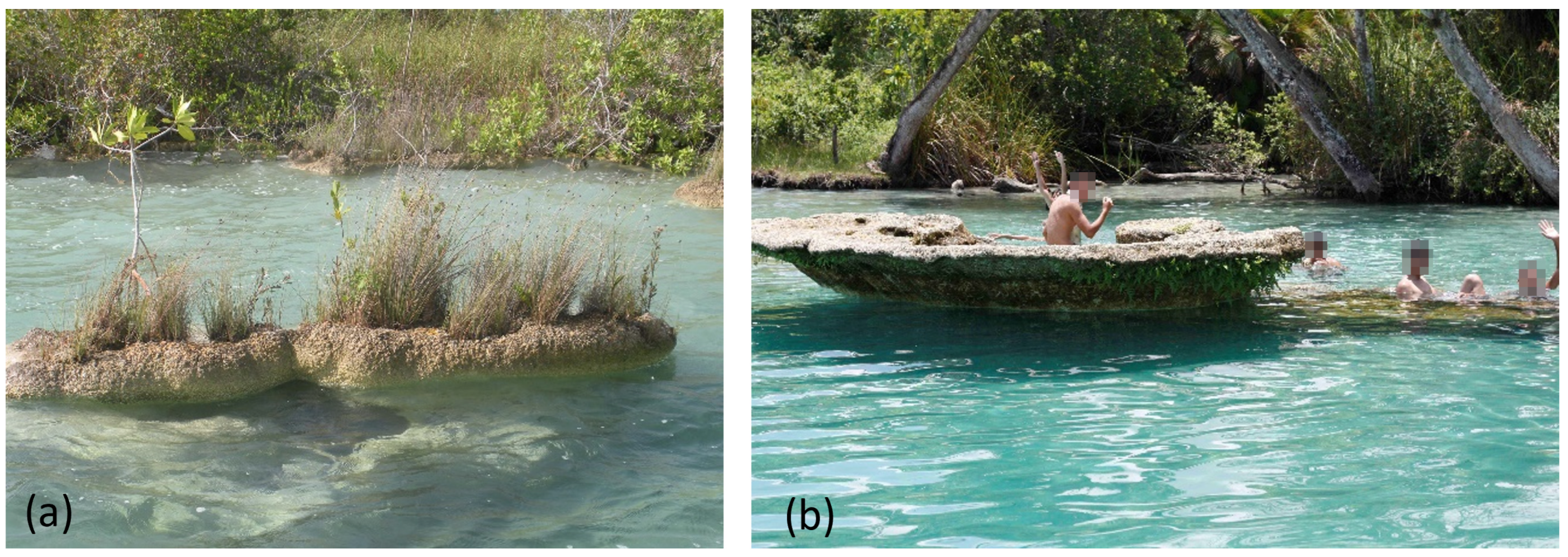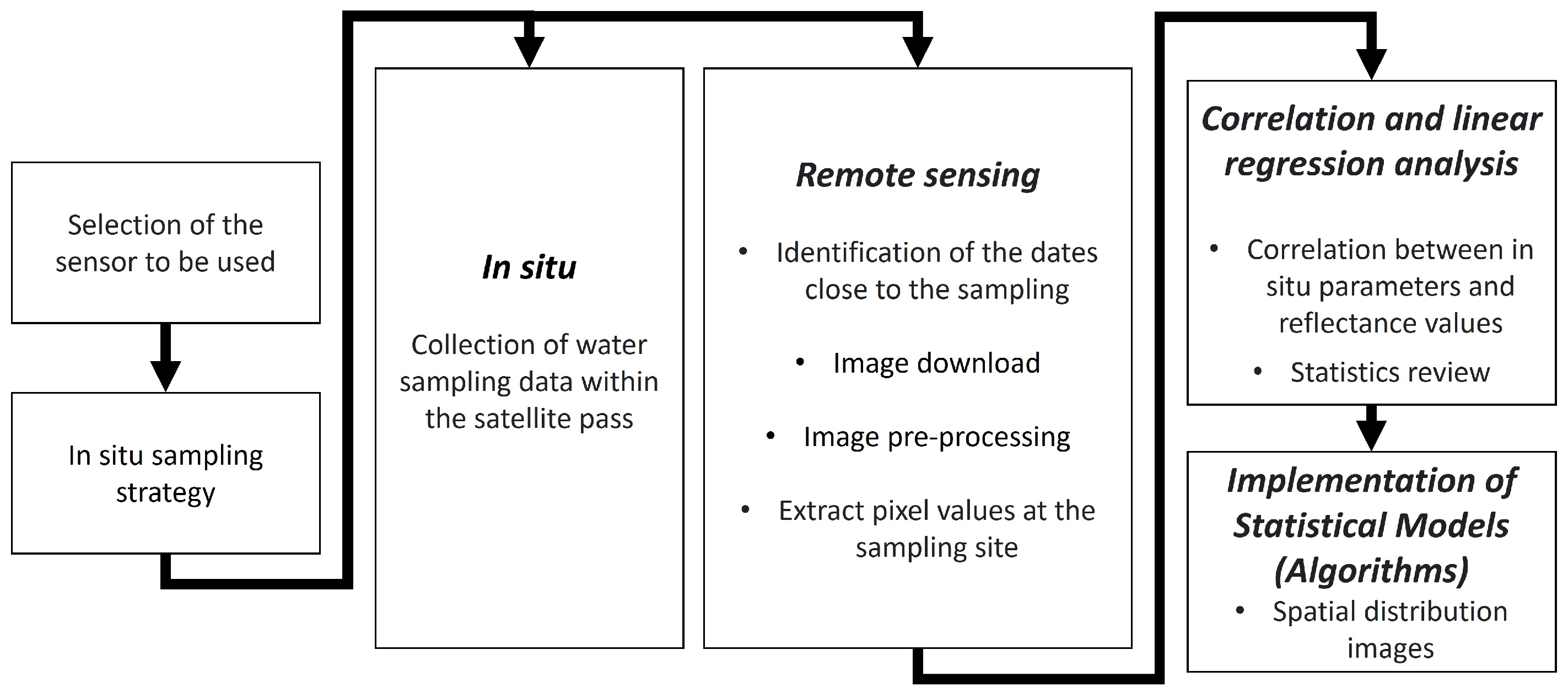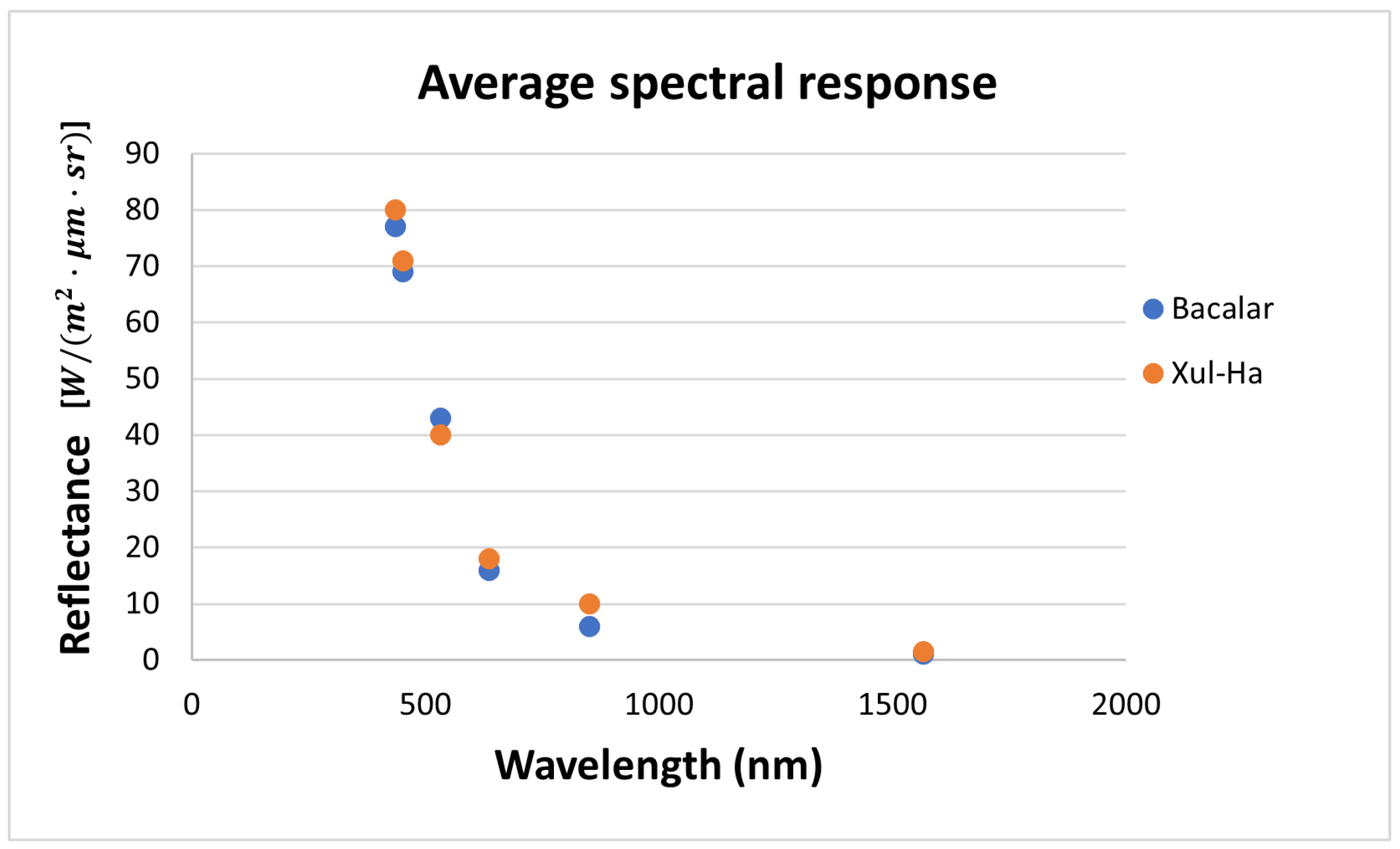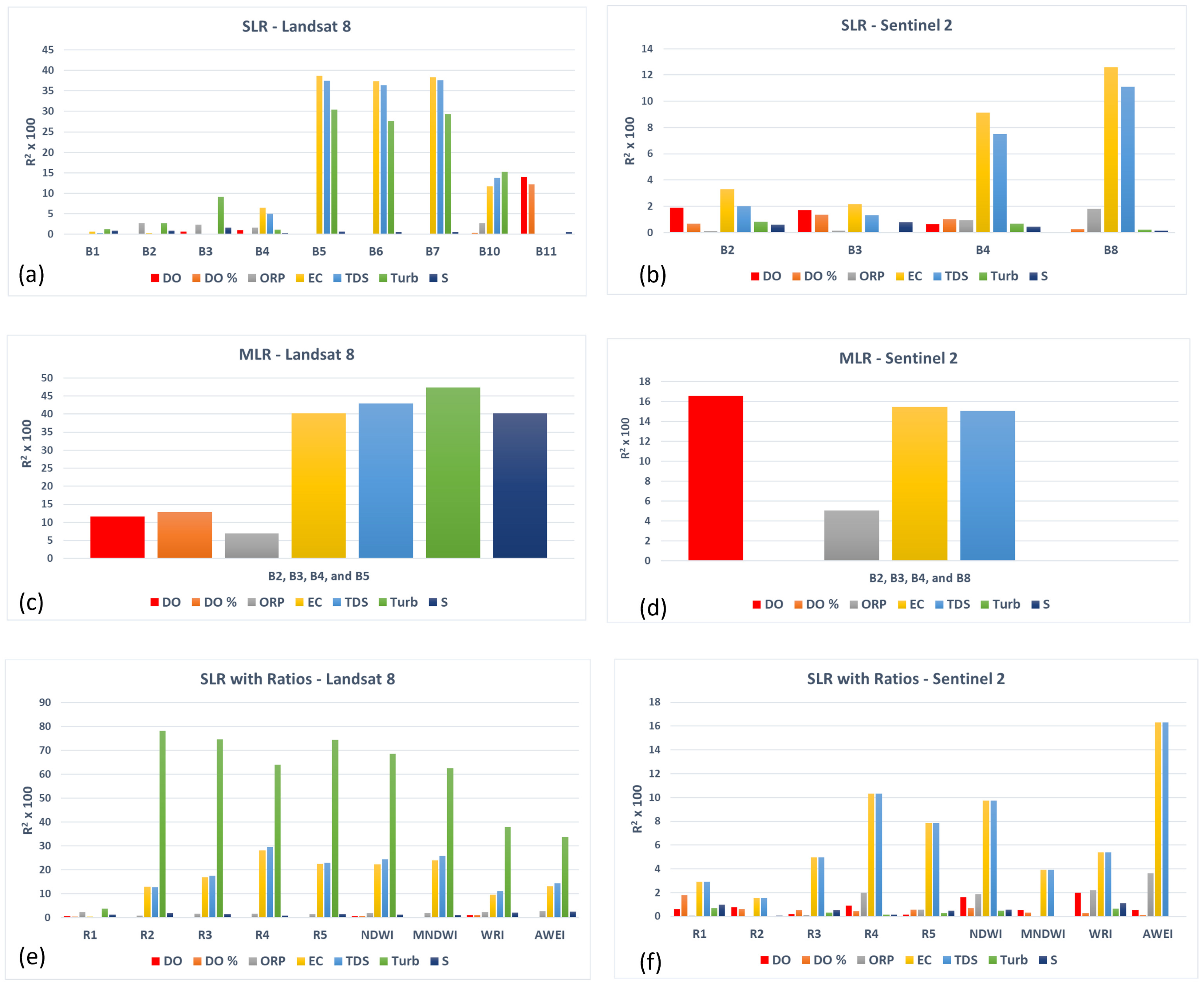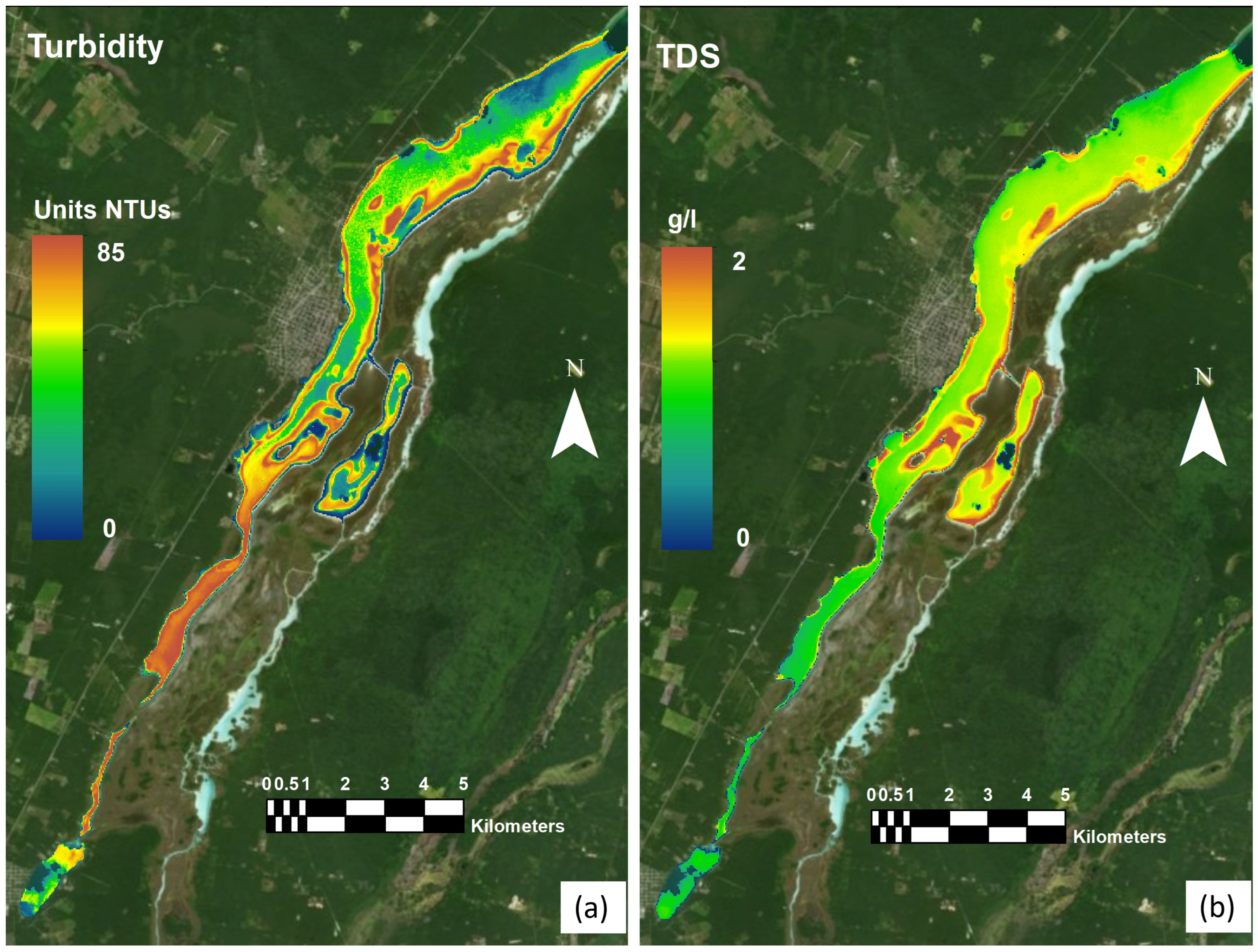1. Introduction
The rapid growth of the world population in recent decades has led to a greater demand for natural resources and, consequently, to an increase in industrial and agricultural activities to satisfy the basic needs of the population [
1]. This has generated greater stress on water resources, causing their direct or indirect contamination, and as a result, many water reserves worldwide have been compromised in both quantity and quality. For example, in the karstic aquifer of the Yucatán Peninsula (YP), Mexico, several chemical compounds, such as fertilizers, agrochemicals, and heavy metals [
2,
3], pollutants derived from anthropogenic activities, such as caffeine, hormones, and antibiotics [
4,
5], as well as bacteria (coliforms), viruses and even microplastics have been detected [
6,
7,
8]. Contamination causes eutrophication of freshwater ecosystems, which allows the proliferation of cyanobacteria, which can produce microcystins, which are toxic to human and animal health [
9]. Consequently, the development of water resources management plans that include water quality assessments has become a predominant need in order to ensure water quality for its various consumption purposes.
Traditionally, the implementation of water quality assessments depends on the parameters to be measured, which can include laboratory analyses of samples taken during fieldwork as well as in situ measurements. In both cases, these measurements only provide localized or punctual information about the water body and not from their totality. Therefore, extensive sampling is required to obtain an accurate representation of the spatial variability of water quality parameters, which increases the cost associated with monitoring. Furthermore, the choice of sampling methodology depends on whether the evaluation will be carried out in surface water (rivers, lakes, lagoons, ocean) or groundwater (aquifers). It also depends on other limiting factors, either technical or associated with fieldwork, e.g., the inaccessibility of the sampling sites. These factors make the monitoring of water quality in real-time, or on a regular basis, a laborious and costly task to implement [
10].
One solution to this problem is to use tools based on remote sensing, which can contribute to making monitoring more accessible and efficient [
11]. Due to technological advances, the use of remote sensing has increased in recent years since, together with in situ monitoring, it has great potential for the analysis of surface water masses, whether marine or continental [
12,
13,
14,
15,
16].
Remote sensing has been used to evaluate relevant water quality parameters such as total dissolved solids, depth with Secchi disk, turbidity, chlorophyll-a, total nitrogen, total phosphorus, and dissolved organic matter, among many others [
17,
18,
19,
20,
21]. This has been accomplished because the contaminants absorb and scatter solar radiation in the water column, so they have a specific spectral response. Therefore, it has been possible to make a direct correlation between the measured parameters and the optical properties of the water, showing that it is possible to monitor water quality parameters with enough precision.
However, despite the use of remote sensing in continental waters, most studies have been conducted in contaminated waters with eutrophic or hypertrophic conditions [
22,
23,
24], so oligotrophic or mesotrophic waters have been studied less [
21]. The main reason is that oligotrophic waters have weak optical characteristics with a low signal-to-noise ratio for remote sensing; that is, they have a low spectral response in some physicochemical and biological parameters, such as pH, organic matter, and chlorophyll, which has hindered its adequate inclusion in the usual monitoring schemes of water resources. Therefore, a more precise evaluation with remote sensing is needed for water bodies with oligotrophic characteristics or close to them.
An oligotrophic water body with a high ecological value is the Bacalar Lagoon in Quintana Roo, Mexico, also known locally as Laguna de los 7 colores (Lake of Seven Colors). This lagoon has become an important tourist destination due to its ecological appeal and the presence of stromatolites, which are rock structures built by colonies of microscopic organisms known as cyanobacteria that do photosynthesis. Stromatolites are very important because they are evidence of the oldest known life on Earth and are part of the most important fossil record of early microbiological life [
25]. The formation of stromatolites is as follows: once the soil settles in shallow water, cyanobacteria use water, carbon dioxide, and sunlight to create their food. Often, a layer of mucus forms over the cyanobacterial cell mats, joining the sedimentary particles and building additional layers until mounds are formed [
26]. In
Figure 1a, stromatolites from the Bacalar lagoon can be seen. Unfortunately, in recent years, anthropogenic contamination in this lagoon has progressively increased due to the discharge of untreated wastewater, deforestation, the use of fertilizers in agriculture, and the high tourist demand [
27,
28,
29,
30]. Therefore, in some seasons of the year, water with mesotrophic and eutrophic characteristics has been detected in some areas along its extension [
31]. Although it has not been fully evaluated how stromatolites are being affected by contamination, it is known that variations in the physicochemical properties of water can affect its diversity, composition, and growth rates [
32,
33,
34]. Additionally, they are also being directly affected by tourists due to ignorance and lack of adequate signs, as can be seen in
Figure 1b. Therefore, the water monitoring of this lagoon has become a priority issue for the authorities and ecological groups of the Quintana Roo state.
In order to contribute to conservation efforts in Bacalar Lagoon, in this work, we present a systematic study to predict the spatial variability of a set of six physicochemical parameters frequently used in water quality assessments [
35]: dissolved oxygen (DO), total dissolved solids (TDS), oxidation–reduction potential (ORP), electrical conductivity (EC), salinity (S), and turbidity (Turb). This is achieved through correlation and linear regression analyses between in situ measurements of these parameters with remote sensing images from Landsat 8 and Sentinel 2 sensors. The results for EC, S, Turb, and TDS are in agreement with the values reported for this lagoon, highlighting the feasibility of using remote sensing tools to monitor oligotrophic water bodies.
3. Results and Discussion
3.1. Average Spectral Response
From the point of view of the spectral response, the points evaluated in the Xul-Ha Lagoon behaved uniformly, unlike the points evaluated in the Bacalar Lagoon. This difference was more accentuated in the reflectances of the visible spectrum, which indicates that the penetration of light was different in Bacalar, mainly due to the different depths that occur in it. However, the average spectral response for both lagoons was similar, as can be seen in
Figure 4. For this reason, all points from both study sites were considered as a single data set for the analysis of correlations and linear regressions, improving statistical representativeness.
3.2. Correlation and Linear Regression Analysis
Correlation and linear regression analyses were carried out using the individual bands, the sets of bands, and the band ratios for each physicochemical parameter considered. The correlation and determination coefficients obtained for each case can be seen in the tables in
Appendix A.2.
Figure 5a,b shows the coefficients of determination
obtained from the SLR analysis on a percentage scale using the individual bands of the images Landsat 8 and Sentinel 2. It is observed that, for the Landsat 8 image, the maximum values of the coefficient of determination are presented in the near, mid, and far infrared bands, i.e., in bands 5, 6, and 7, respectively. These results contrast with those reported in [
14], where it is mentioned that the ideal reflectance values for the water surface are greater in the visible spectrum range and disappear in the infrared range, just when the absorbance is higher. However, in that study, the analysis was carried out in water with eutrophic characteristics, where the spectral response can be very different from the response of water with or close to oligotrophic characteristics. For the SLR analysis using the Sentinel 2 image, only the bands with the highest spatial resolution (bands 2, 3, 4, and 8) were used. The behavior in the bands was similar to those obtained with the Landsat 8 image, although the
values obtained with Sentinel 2 are lower than those obtained with Landsat 8. For the latter,
values close to
are obtained (bands 5 to 7), while for Sentinel 2 a maximum value of
is obtained in the near-infrared band (band 8).
The fact that the linear regressions obtained with Sentinel 2 have a lower
coefficient can be explained in terms of the spatial resolution of each image. The Sentinel 2 image has a higher spatial resolution (10 m), so the pixels evaluated can be very specific in terms of the surface they represent, while the Landsat 8 image has a lower spatial resolution (30 m), so their reflectances are average values that can include various surface types. On the other hand, the spectrum range occupied by each of the bands in each sensor is different. For Landsat 8 the bands of the visible spectrum are broader, while the spectral resolution for Sentinel 2 is lower and more specific, mainly in the green and red ranges. Regardless of the image used, it can be observed that for the SLR analysis, the maximum values of
are given for the physicochemical parameters EC and TDS, which present a high correlation between them due to a close relationship from the chemical point of view [
62]. In addition, both parameters are indicators of the salinity level of the water.
On the other hand,
Figure 5c,d shows the coefficients of determination
obtained from the MLR analysis. For each analysis, the spectrum bands that have the highest reflectance values in the water spectral signature were selected, that is, bands 2 (blue), 3 (green), 4 (red), and 5 (NIR) for Landsat 8, and bands 2 (blue), 3 (Green), 4 (red) and 8 (NIR) for Sentinel 2. Using the Landsat 8 image, the parameters that obtained the highest correlation were Turb, TDS, S, and EC, while for the Sentinel 2 image, they were DO, EC, and TDS. However, the last coefficients were lower than those obtained with the Landsat 8 image, similar to the results obtained from the SLR analysis. It is important to note that, for the Landsat 8 image, a better correlation for salinity was obtained with the MLR analysis than with the SLR analysis. Similarly, for the Sentinel 2 image, a better correlation was obtained for dissolved oxygen using the MLR analysis.
The
values for the SLR with ratios can be seen in
Figure 5e,f. The maximum value of
(≈0.8) was obtained for the parameter Turb, using the band ratio R2 (Green/Red) and the Landsat 8 image. Therefore, it can be inferred that this parameter affects the parameters TDS, EC, and S in a complex way. Except for the band ratio R1, all ratios highlighted the parameter Turb, as well as TDS and EC, although the latter with
values less than
. It can also be observed that in the band ratios where infrared spectrum bands were used (NDWI, MNDWI, WRI, and AWEI), the
values were below the maximum
obtained with the band ratio R2. The above contrasts with the results reported in [
63], where it is indicated that the NDWI ratio could be used to detect subtle water variations.
Finally, it can be observed that the highest values of the coefficient of determination for all parameters were obtained with the MLR analysis, except for the parameter Turb, which had the highest using SLR with the band ratio R2.
3.3. Final Regression Algorithms
Based on the analysis in the previous section, the statistical models (algorithms) that were significant and presented the highest values of the coefficient of determination
were selected for each of the physicochemical parameters considered. The best algorithms were obtained with the Landsat 8 image. The final regression algorithms used to generate the spatial distribution of each parameter are presented in
Table 3.
It is important to mention that no images were generated for dissolved oxygen in the two forms evaluated nor for the oxidation–reduction potential since their values were less than , which is considered a low value to use the regression algorithms to predict spatial distributions from the reflectance images. Although the Bacalar lagoon system is wider in extent, the resulting images are limited to the study area without the presence of clouds, despite the analysis carried out to filter them. This is because the filtering process modifies the real reflectances in cloud-covered pixels, so they should not be used to estimate the physicochemical variables in the prediction processes.
Figure 6 shows the spatial distributions of electrical conductivity and salinity. It can be observed that in the region near the town of Bacalar, on the west side of the lagoon, the values of the electrical conductivity EC are smaller than on the east side. Likewise, they decrease from north to south in the direction of Xul-ha Lagoon. This behavior has already been described previously [
38] and is because the lagoon is shallower in the eastern part than in the western part. The shallow depth of the lagoon promotes higher evaporation, increasing salinity S and, consequently, the EC values. Similarly to the north of the lagoon, there is less interaction with groundwater than to the south of the lagoon, which explains the decrease in the EC parameter from north to south. Furthermore, it can be seen that the generated EC image is similar to the S image, indicating a high correlation between both parameters.
The average EC and pH values of the water, obtained from the in situ measurements, were
S/cm and
, respectively (see
Appendix A.1)—similar to values previously reported in this lagoon [
25,
30,
33,
38], and in the range of values reported for water bodies with oligotrophic characteristics [
38]. Another work with comparable results is the one reported in [
64], in the area known as Los Rápidos (The Rapids), where an EC of 1220
S/cm was reported. In the case of the EC prediction map, the value obtained for the area is around 2000
S/cm.
Although the degree of water eutrophication involves measuring total phosphorus, nitrogen, and chlorophyll [
65], from the spatial values of EC and pH, it can be inferred that at the time of measurements, the Bacalar lagoon presented oligotrophic conditions in most of its extension, mainly towards the south of the lagoon, decreasing slightly towards its northern section. However, this condition has changed over time, and punctual eutrophication has occurred temporarily in some areas along this lagoon [
31].
On the other hand,
Figure 7 shows the spatial distributions of turbidity and total dissolved solids, which are considered aesthetic parameters of water. Turb is not a parameter regulated by the Official Mexican Standard (NOM-001-SEMARNAT-2021) [
66]; however, it is one of the most important factors that restrict the growth of stromatolites [
67]. As can be seen from this figure, the highest turbidity values occur in the narrowest section of the lagoon, to the south of it, before and after Los Rápidos. Stromatolites are found at this site, which may be affected due to the estimated concentrations of this parameter (85 NTUs). Likewise, high Turb values are found to the north of the lagoon, in its eastern section. It is important to emphasize that this parameter was best estimated using the SLR analysis with the R2 ratio (green/red). This result agrees with the statements that indicate that the spectral signature of the properties within the turbidity presents higher reflectance values in the spectrum ranging from 400 nm to 800 nm (this interval covers the green and red wavelengths, as can be seen in
Table 1).
Concerning the TDS, the average value obtained from field measurements was
g/L. It can be observed that the TDS values obtained in the western part of the lagoon, near the town of Bacalar, are similar to those reported in other studies in the same area [
30,
68] and are close to or above the limits allowed by current Mexican regulations [
66,
68].
In general, we can observe that the linear statistical models obtained reproduce, from a qualitative point of view, measurements reported for the parameters EC, S, Turb and TDS in various sites of the lagoon. However, it would be important to conduct more studies that consider more sophisticated models, and other satellite images with hyperspectral characteristics, to obtain better adjustments to the spatial behavior of these and other physicochemical parameters of the lagoon water.
It is important to mention that although the parameter data obtained in situ are representative of the period in which they were measured, they are similar to those reported in other years and different seasons of the year. This is due to the almost oligotrophic conditions of the lagoon that cause little temporal variability in the monitored data. However, it must be considered that the dynamics within the lagoon could be an important factor that modifies the results. In the case of Bacalar, monitoring in the months when extreme weather phenomena occur, e.g., in the cyclone and hurricane season, would be of vital importance since these phenomena alter the dynamics and composition of surface and groundwaters.
Regarding human activities, due to the accelerated increase in population in coastal areas, there is an urgent need for new and more cost-efficient methods for spatially explicit monitoring approaches at peatlands. For a better understanding of the ecological and hydrological behavior of the Bacalar Lagoon, remote sensing allows the generation of specific monitoring parameters due to the increase in human activities that will affect the fragile conditions of the lagoon and the stromatolites that reside in it, enabling rapid countermeasures to mitigate or minimize potential harm or hazard and even to decide if recurrent monitoring becomes necessary.
4. Conclusions
From the analysis of correlation and linear regression between images obtained from Landsat 8 and Sentinel 2 sensors, with field measurements of a set of physicochemical parameters, the statistical models that best represent the spatial behavior of the EC, S, Turb, and TDS in the Bacalar Lagoon were obtained.
Except for the Turb parameter, the most accurate algorithms were obtained using the Landsat 8 image and MLR analysis, which covers and considers a broader range of the electromagnetic spectrum. The set of parameters measured in the field allowed for an indirect analysis of the water quality of this lagoon, finding that at the time of the measurements, oligotrophic conditions were present in most of its extension.
From a general point of view, the results obtained demonstrate the feasibility of using remote sensing tools to frequently monitor large water bodies susceptible to contamination at a low cost compared to laboratory analysis.

